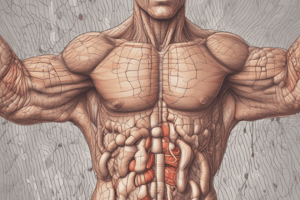Podcast
Questions and Answers
What happens during Phase two of the Valsalva maneuver when it reaches a certain point?
What happens during Phase two of the Valsalva maneuver when it reaches a certain point?
- It enhances respiratory efficiency.
- It begins to cause negative physiological effects. (correct)
- It promotes prolonged hyperventilation.
- It has no impact on cardiac output.
What type of control is the diaphragm under?
What type of control is the diaphragm under?
- Involuntary control only.
- Somatic autonomic nervous system control. (correct)
- Voluntary control only.
- Complete autonomic nervous system control.
During active expiration, which mechanism is primarily utilized to increase gas exchange efficiency?
During active expiration, which mechanism is primarily utilized to increase gas exchange efficiency?
- Additional muscles to push air out. (correct)
- Increased oxygen uptake.
- Quickened breath rate.
- Relaxation of the diaphragm.
What occurs to the phrenic nerve's function if it is damaged?
What occurs to the phrenic nerve's function if it is damaged?
What is a consequence of hyperventilating?
What is a consequence of hyperventilating?
What characterizes the Valsalva maneuver?
What characterizes the Valsalva maneuver?
When the Valsalva maneuver is performed, what is the effect on venous return?
When the Valsalva maneuver is performed, what is the effect on venous return?
Which of the following is true about coughing?
Which of the following is true about coughing?
What occurs to cardiac output while performing the Valsalva maneuver?
What occurs to cardiac output while performing the Valsalva maneuver?
How does inhalation differ from exhalation in terms of energy usage?
How does inhalation differ from exhalation in terms of energy usage?
What is the primary function of the diaphragm during normal breathing at rest?
What is the primary function of the diaphragm during normal breathing at rest?
What effect does the Valsalva maneuver have during its first phase?
What effect does the Valsalva maneuver have during its first phase?
Which muscles are primarily involved in active expiration?
Which muscles are primarily involved in active expiration?
What role do baroreceptors play during the Valsalva maneuver?
What role do baroreceptors play during the Valsalva maneuver?
How does the nervous system control the depth of breathing?
How does the nervous system control the depth of breathing?
What is a potential risk for patients with cardiovascular conditions that engage in the Valsalva maneuver?
What is a potential risk for patients with cardiovascular conditions that engage in the Valsalva maneuver?
What component of the cough reflex is responsible for the deep inspiration?
What component of the cough reflex is responsible for the deep inspiration?
What could be a consequence of injuries to inspiratory or expiratory muscles?
What could be a consequence of injuries to inspiratory or expiratory muscles?
Which phase of the Valsalva maneuver follows the initial increase in thoracic pressure?
Which phase of the Valsalva maneuver follows the initial increase in thoracic pressure?
What is the primary purpose of recruiting additional muscles during high-intensity exercise ventilation?
What is the primary purpose of recruiting additional muscles during high-intensity exercise ventilation?
Flashcards
Ventilation
Ventilation
The movement of air in and out of the lungs.
Gas exchange
Gas exchange
The process of oxygen uptake and carbon dioxide release in the alveoli.
Inspiration
Inspiration
The active process of taking air into the lungs.
Expiration
Expiration
Signup and view all the flashcards
Diaphragm
Diaphragm
Signup and view all the flashcards
Active Inspiration
Active Inspiration
Signup and view all the flashcards
Active Expiration
Active Expiration
Signup and view all the flashcards
Valsalva Maneuver
Valsalva Maneuver
Signup and view all the flashcards
Cough Reflex
Cough Reflex
Signup and view all the flashcards
Sneeze Reflex
Sneeze Reflex
Signup and view all the flashcards
Valsalva Maneuver
Valsalva Maneuver
Signup and view all the flashcards
Phase Two Valsalva
Phase Two Valsalva
Signup and view all the flashcards
Diaphragm Control
Diaphragm Control
Signup and view all the flashcards
Inhalation
Inhalation
Signup and view all the flashcards
Active Expiration
Active Expiration
Signup and view all the flashcards
Phrenic Nerve Damage
Phrenic Nerve Damage
Signup and view all the flashcards
Hyperventilation
Hyperventilation
Signup and view all the flashcards
Stretch Response
Stretch Response
Signup and view all the flashcards
Cough
Cough
Signup and view all the flashcards
Somatic Nervous System
Somatic Nervous System
Signup and view all the flashcards




